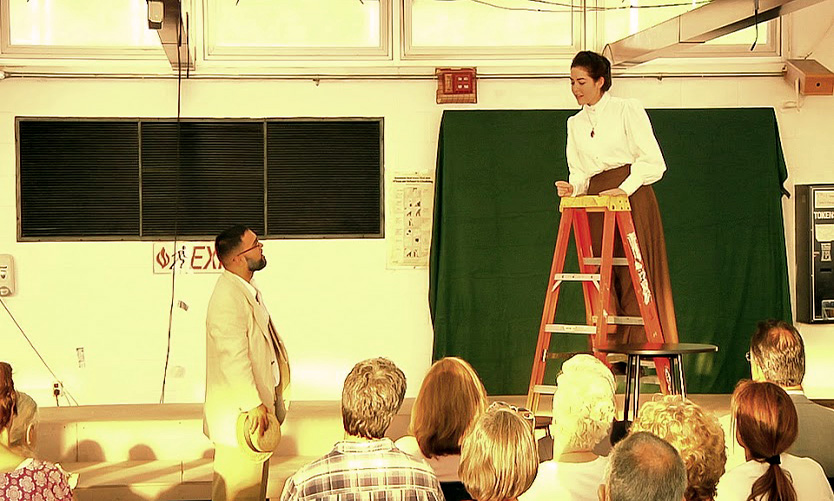Staging Our Town in an Incarcerated Cemetery
You can't take an intermission at Sing Sing, and you cannot have a blackout. Well, this year, a blackout was not available to us because the lights never go out in the room where we presented the play and because the circuits in that space couldn't handle the wattage of stage lighting. Also, there are only four movable instruments inside the facility to my knowledge, and they are the very state of 1961 electrics art. These two facts (no intermission, no lighting) left me with an Our Town challenge. How would we make the transition out of the wedding scene at the end of Act II and into the cemetery in Act III? How would we travel from "a perfectly lovely wedding" to "the dead don't stay interested in us living people for very long"?
In prisons around this country, there are 'potter's fields,' where indigent and isolated inmates are buried when they die while incarcerated. While it is starting to change, for a very long time, a prisoner did not get his name on his grave marker; he merely got his prisoner number. Burial was complete.
Back to solving that transition between Act II and Act III.
One thing I have available to me at Sing Sing is a lot of bodies. More bodies than one could ever afford in a non-profit production. So I knew I wanted a big cemetery. I wanted to see not just the named characters that we've followed through the play, but also those unnamed dead that we forget or never knew bout in the first place. I knew I wanted to acknowledge those disappeared men who die while incarcerated. During the tablework phase of rehearsals at Sing Sing, the incarcerated actor playing Editor Webb said, "We're just like Emily in Act III. We're the dead. The only difference is that hopefully, when we come home, we can make different choices."
We really investigated Emily's journey back to "live all those days over again" and wrangled with why that should be so profoundly painful. I asked the men, "If you could go back to the day before you agreed to do whatever got you to Sing Sing, if you could relive that day, that last truly free day, knowing that it would still end up with you getting involved in what led to your conviction, would you do it?" The answer was a resounding "no."
So I asked several men who are part of the theatre group, but who were not available to be in this play because they are in college right now (my favorite way to lose actors, by the way), if they wanted to play 'dead guys.' They were in. They thought it would be easy. Show up and sit through Act III. There were a lot of zombie jokes for a bit. Ha-ha.
In collaboration with actress and facilitator Kate Kenney, who was also playing the role of Emily Webb, we worked with the men to create a Suzuki-inflected slow walk with a focus on looking for that "something way down deep that's eternal about every human being." We talked a lot in rehearsals about how one can live one's life "every, every minute" when one is incarcerated, when it might be a mental health best practice to tune out; we explored the relationship between one man's suffering in prison and the life of the universe. I asked each of those 'dead guys' to enter the playing space very slowly, walk to a chair in the wedding congregation, lift that chair in a painfully slow arc over his head and slowly to proceed to his 'grave,' thinking all the while about what might be the eternal part of himself.
As the stage manager introduced us to the cemetery and talked about the search for eternal within the human, the unnamed dead slowly, one by one, began to move. When we performed the play for an incarcerated audience, last Wednesday and Thursday, there was some initial laughter as the 'walking dead' began to appear. This was partly the same laughter that you get when high school or college kids recognize their friends onstage; this was partly 'those guys look funny' laughter. But it abruptly stopped as the first of the unnamed dead slowly sank into his chair, his grave, and the wave of dead continued to move inexorably across the playing space. Gradually, the named dead (Mrs. Gibbs, Simon Stimson, Wally Webb, etc.) began to emerge, "here's your friend, Mrs. Gibbs ..." The numbers of the dead seemed relentless, as old as history.
When we performed the play for the population of the prison, the unnamed dead, in their state green uniforms, were wearing, of course, exactly the same thing as the audience. Which made the audience very potently the continuation of the cemetery itself. Suddenly there were 200 dead men, looking across at one another.
It was a beautiful moment of stagecraft, I confess, and each time we ran it in rehearsal or in performance, I caught myself holding my breath.
Howard Sherman, in his beautiful and generous appreciation of our project, wrote, "But as these nine men sat and stared out, unspeaking, I could not help but see them as prisoners and actors all at once, locked away for crimes I knew nothing of, for how long I did not know. Were their lives over, as in the play? Was the play itself their escape, or even a sign of their eventual redemption?"
Those were just some of the thoughts we were hoping to elicit.




